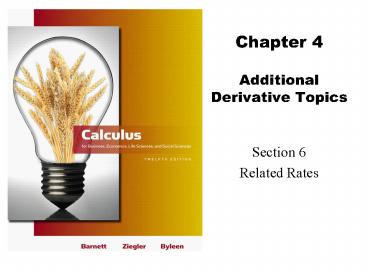Chapter 4 Additional Derivative Topics - PowerPoint PPT Presentation
1 / 13
Title:
Chapter 4 Additional Derivative Topics
Description:
Chapter 4 Additional Derivative Topics Section 6 Related Rates Learning Objective for Section 4.6 Related Rates The student will be able to solve related rate ... – PowerPoint PPT presentation
Number of Views:48
Avg rating:3.0/5.0
Title: Chapter 4 Additional Derivative Topics
1
Chapter 4Additional Derivative Topics
- Section 6
- Related Rates
2
Learning Objective for Section 4.6 Related Rates
- The student will be able to solve related rate
problems and applications.
3
Introduction
Related rate problems involve three variables an
independent variable (often t time), and two
dependent variables. The goal is to find a
formula for the rate of change of one of the
independent variables in terms of the rate of
change of the other one. These problems are
solved by using a relationship between the
variables, differentiating it, and solving for
the term you want.
4
Example 1
A weather balloon is rising vertically at the
rate of 5 meters per second. An observer is
standing on the ground 300 meters from the point
where the balloon was released. At what rate is
the distance between the observer and the balloon
changing when the balloon is 400 meters high?
5
Example 1
A weather balloon is rising vertically at the
rate of 5 meters per second. An observer is
standing on the ground 300 meters from the point
where the balloon was released. At what rate is
the distance between the observer and the balloon
changing when the balloon is 400 meters high?
Solution Make a drawing. The independent
variable is time t. Which quantities that change
with time are mentioned in the problem? We use x
distance from observer to balloon, and y
height of balloon.
x
y
300
6
Example 1
dy/dt is given as 5 meters per second. dx/dt is
the unknown. We need a relationship between x and
y 3002 y2 x2 (Pythagoras) Differentiate
the equation with respect to t We are looking
for dx/dt, so we solve for that
x
y
300
7
Example 1
Now we need values for x, y and dy/dt. Go back
to the problem statement y 400 dy/dt
5 dx/dt (400/500)5 4 m/sec
x
y
300
8
Solving Related Rate Problems
- Step 1. Make a sketch.
- Step 2. Identify all variables, including those
that are given and those to be found. - Step 3. Express all rates as derivatives.
- Step 4. Find an equation connecting variables.
- Step 5. Differentiate this equation.
- Step 6. Solve for the derivative that will give
the unknown rate.
9
Example 2
A rock is thrown into a still pond and causes a
circular ripple. If the radius of the ripple is
increasing at 2 feet per second, how fast is the
area changing when the radius is 10 feet? Use A
pR2
10
Example 2
A rock is thrown into a still pond and causes a
circular ripple. If the radius of the ripple is
increasing at 2 feet per second, how fast is the
area changing when the radius is 10 feet? Use A
pR2 Solution Make a drawing. Let R radius,
A area. Note dR/dt 2 and R 10 are given.
Find dA/dt. Differentiate A pR2.
11
Related Rates in Business
Suppose that for a company manufacturing
transistor radios, the cost and revenue equations
are given by C 5,000 2x and R 10x
0.001x2, where the production output in 1 week
is x radios. If production is increasing at the
rate of 500 radios per week when production is
2,000 radios, find the rate of increase in (a)
Cost (b) Revenue
12
Related Rates in Business(continued)
Solution These are really two related rates
problems, one involving C, x and time t, and one
involving R, x, and t. Differentiate the
equations for C and R with respect to time. (a)
Cost is increasing at the rate of 1,000 per
week.
13
Related Rates in Business(continued)
(b) Revenue is increasing at the rate of
3,000 per week.























![Artificial Intelligence Lecture 8: [Part I]: Selected Topics on Knowledge Representation PowerPoint PPT Presentation](https://s3.amazonaws.com/images.powershow.com/7421234.th0.jpg?_=20151128083)







